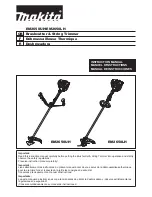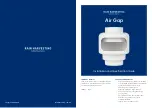
Chapter 2—Safety Considerations
9
Warning! To reduce the risk of potentially dangerous electrical shock, this work should only be
performed by a qualified service technician, and then only with the instrument
disconnected from all sources of power.
Interference below about 10 MHz is most likely to be caused by radio-frequency currents flowing
in the input and output cables, in the digital interface cables, or in the power line cord. The use of
coaxial cables in making the analog signal input/output connection will usually prevent these
lines from becoming a source of "below 10 MHz" radio frequency interference. Two approaches
are suggested for reducing interference that has its source in the digital interface cables. The
first is simply to shield these cables. The second is to provide a heavy ground connection
between the grounds of all equipment sharing the interface bus. This is accomplished by
strapping the chassis together with a metal braided or solid strap. (A solid strap does a better job
but is more clumsy. Copper, aluminum, or brass are the recommended materials).
Because the Model 273A has an internal low pass filter connected to the power line, the ac line
cord is unlikely to be a source of radio frequency interference. If the internal filter seems to be
inadequate, try decoupling the power line with an external filter. At frequencies below 100 kHz,
an external isolation transformer could be helpful.
At frequencies above 10 MHz, these measures may not suffice to prevent radiation from being a
problem, particularly at VHF frequencies. Additional measures will then be required. Shielding is
generally effective. A suitable shield can be constructed using metal foil, wire screening, or
similar materials.
Once the apparatus is completely surrounded by the shield (taking care not to unduly restrict
ventilation), the only additional requirement is to install low-pass filters where lines pass through
the shield (all openings through the shield should be as small as possible). A capacitor between a
line and the shield can function as a suitable low-pass filter. The leads of the capacitor should be
as short as possible. This requirement is optimally satisfied by using coaxial feed-though
capacitors.
In the case of a signal lead, it is essential that the capacitor's value be such as to attenuate the
interference frequencies without unduly attenuating critical frequency components of the signal
itself. The need to keep fitter capacitor leads short cannot be overemphasized. Long leads
establish sizable ground loops and may additionally act as radiating antennae.
Coaxial cables are a special case in that the cable shield acts as an extension of the enclosure
shield. This being the case, the filter can be mounted in a shielded box fitted with coaxial
connectors without undue concern for keeping the box extremely dose to the enclosure. If more
convenient to do so, it can be located at some distance from the enclosure as long as the
integrity of the coaxial shield is maintained.
The techniques described are extraordinary measures that should be required for
unusual cases only. If they are applied with care, radio frequency interference should be
reduced to an acceptably low level in all but the most critical applications. However, if these
techniques are applied incorrectly, the efforts to reduce the interference could prove
disappointing. Users are advised to contact the factory for advice in the case of a problem that
does not yield to these measures.
2.8. Transient Sensitivity
Generally speaking, the design and construction techniques used in equipment manufactured by
Princeton Applied Research are conducive to assuring normal operation in the presence of
moderate transient levels. Although these provisions are sufficient for operation in most places
where this equipment is used, it is certainly possible for transient levels in particular
Содержание 273A
Страница 1: ...0RGHO 3RWHQWLRVWDW DOYDQRVWDW 8VHU V 0DQXDO 8VHU V 0DQXDO 3ULQWHG LQ 86...
Страница 6: ...vi Model 273A Potentiostat Galvanostat User s Manual...
Страница 10: ...4 Model 273A Potentiostat Galvanostat User s Manual...
Страница 23: ...Chapter 3 Characteristics 17 Fig 3 Model 273A Simplified Block Diagram...
Страница 26: ...20 Model 273A Potentiostat Galvanostat User s Manual...
Страница 66: ...60 Model 273A Potentiostat Galvanostat User s Manual...
Страница 70: ...64 Model 273A Potentiostat Galvanostat User s Manual...
















































